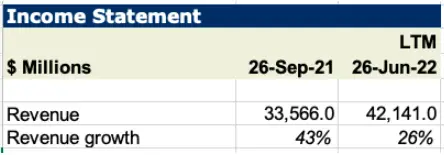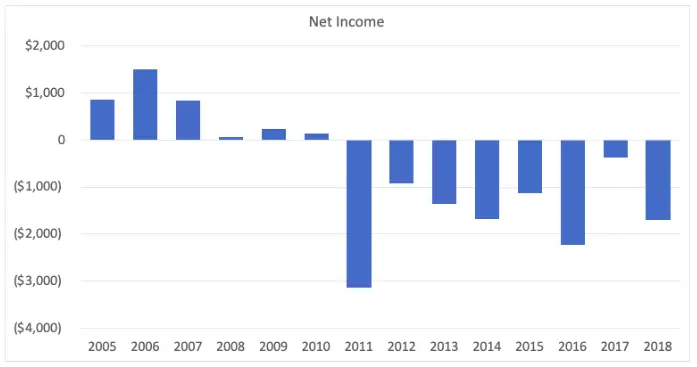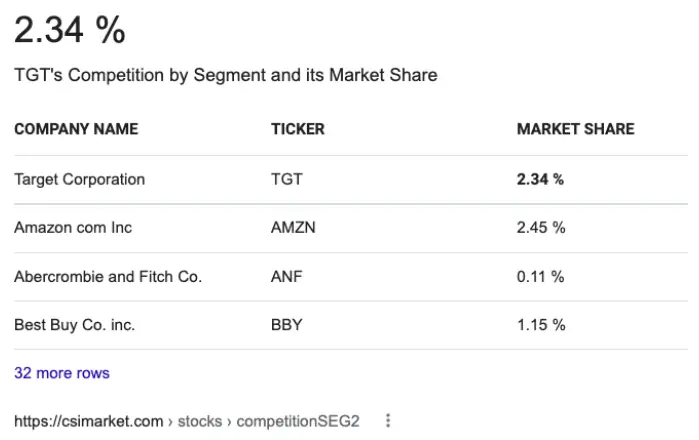How to determine the financial health of a company varies for different stages of the company and for different industries.
For example, a manufacturing company may have very low profit margins but could be deemed a healthy company if their manufacturing plant is operating at or near capacity and they have stable cash flows.
Or another example is a technology growth company with significant losses may not be considered as a financially sound company. But that perspective may change if you knew that the company has been decreasing the amount of losses every quarter and a cash balance that could sustain them for double digit years.
What does it mean for a company to be financially healthy?
On the low end of the range, it means the company is not and will not be going bankrupt. On the high end of the range, it means the company is going to outpace its peers.
7 ways to determine the financial health of a company
Having said that, I’ve established a set of rule-of-thumb indicators. These general rules can be used across different stages and industries to help assess whether a company has financial stability or is doomed in the future.
These general rules are what I’ve learned from my experience valuing companies in various industries professionally.
And don’t just look at one of these and think you know if the company’s financials are healthy. You should really consider at least the first 5 of these rule-of-thumbs (and more) before deducing whether the company is financially healthy or not.
- Growth
- Profitability
- Free Cash Flow
- Cash
- Revenue Forecastability
- Gross Margin & EBITDA Margin Comps
- Market Share
Click on each of the above (or scroll further down) to read more detail on what you should be looking for.
1. Growth
Which company do you think is financially healthier – a company that had 50% growth in 1 quarter in an industry that is becoming obsolete or a company that had 1% growth in an industry that is a must-have in billions of people’s lives?
One may see 50% growth and immediately think that the first company has healthier financials. But it is not as obvious as that.
The company with 50% growth may have experienced this in one quarter because of an event out of their control and the growth may not be sustainable.
On the other hand, the company with 1% growth may be slowly gaining more market share in an industry where very mature companies that had all the market share are declining in their revenue year over year.
So, it is important to assess the stability of the company’s revenue growth in order to determine whether a company’s financials are healthy.
So, how do you assess the stability of the company’s revenue growth? To answer this, you need to look at the past 3 – 5 years of their financials on a quarterly and annual basis.
Let’s look at an example income statement below. Below are real life companies’ income statements. But, I won’t mention which company, because it’s not relevant to this topic.
The last almost 2 years has seen fantastic growth in revenue.

So, when this company announces their financial report and you see this year’s and last year’s growth, you may think this company is performing financially healthy, because it’s had double digit growth in the past 2 years.
But when we expand it to the last almost 7 years of annual revenue, you see that actually, prior to even the pandemic years, the company’s growth has been wonky.

It fluctuated between negative revenue growth and very slow single-digit growth.
Let’s take a look at another example.

For this company, the revenue growth declined significantly in 2019 and climbed its way back up to a positive growth the following year.
In 2021, the revenue growth saw a huge jump to 19%. Alas, it is too good to be true. The revenue growth is not sustainable, because the last few years have already shown that the company’s growth is unpredictable.
Then, what’s an example of stable revenue growth?
Take a look at this other company example.

The revenue growth doesn’t have to be in the double digits, but what’s important is that the revenue growth has been consistent.
A bonus is if the revenue growth has never declined. A financially healthy company will have had consistent revenue growth year over year (on an annual or quarterly basis).
2. Profitability
Is the company making money? If not, does the company have a path to profitability?
One of the reasons for the tech stocks bust in November 2021 was because the market wanted to recalibrate the market.
From mid-2020, the tech rally saw tech stocks inflate to inexplicable highs. Companies that clearly did not have the fundamental valuation were trading at absurd prices. And in November 2021, there was a correction to solve this problem.
The companies with no profitability were ones that were “punished” the most. And, there’s a good reason for that.
Simply put, a company that is losing money every year has a higher probability of running out of cash and closing down their business.
Needless to say, a company’s profitability is one of the ways to determine the financial health of a company.
Here is my recommendation when determining whether a company has sound profitability. What you should be looking for is different depending on whether a company is already profitable or not.
First, let’s look at when a company is already profitable.
- If a company is already profitable, you want to make sure of 2 things: trend and comparables. If a company had a net income margin (net income divided by revenue) of 10% in one year, you need to analyze if the last 3 years’ net income margin has also been around 10% or lower. If in the last 12 quarters, the net income margin has been increasing from 5% to 10%, then chances are, the company has figured out how to cut costs and increase profitability. But if a company used to have a net income margin of 20% 3 years ago and this year it is 10%, then there is a problem.
- Secondly, you need to check whether the company’s net income margin is in a similar range to competitors that are of a similar size that sells similar offerings. If the net income margin is vastly different, then one company has not figured out how to achieve an efficient operation or various other reasons.
And how about a company that is not profitable yet? If a company is not yet profitable, the most important piece of information you need to know is management’s strategy and execution.
If management has an executable plan – whether that involves revamping their operations, hiring specialized resources, rebranding their products, etc. – and management has had a proven track record of success, then that’s a good start.
Whether a company is public or private, the question to ask is does the company’s management have a clear vision that lays out the path to profitability? And every year, does the company hit their target?
As a case study, look at the net income of Sears from 2005 to 2018:

After 2008, the company took a big hit in the aftermath of the Global Financial Crisis and unfortunately were never able to get back up.
The company’s net income eroded further and continued to be unprofitable starting in 2011 until finally, they declared bankruptcy in 2018.
A financially healthy company will have net income margins in a similar range to its competitors and it will have been positively trending over the years.
And if the company is not profitable yet, the company will have a strong executable plan to become profitable by a certain time frame.
3. Free Cash Flow
Some argue that free cash flow is more important than net income margin (or profitability). The reason is that because there are many non-cash items that affect net income margin, so even if a company is profitable, they may not be bringing in cash.
In my opinion, free cash flow is just as important as profitability, and they should both always be measured when determining the financial health of a company.
Here is a post I wrote on how to calculate the free cash flow. There are a few different ways that you can calculate the free cash flow. For example, another way is to start from net income or EBITDA. But generally speaking, any way you calculate it should result in a similar range of free cash flow.
A positive free cash flow means that the company is generating cash and is not dependent on the cash that is in their bank account.
The rule of thumb is that a company with healthy financials will have a positive free cash flow that has been consistent and growing.
Furthermore, what you want to see is a healthy operating cash flow that is contributing to a positive free cash flow.
So, in addition to calculating the free cash flow to assess whether it has been consistent and positively trending, you want to also look at the cash flow statement and evaluate whether the operating cash flow has also been consistent and growing.
You can read more about analyzing the cash flow statement here.
4. Cash
Another quick and dirty check to determine the financial health of a company is a snapshot of their cash balance.
Look at the most recent balance sheet of the company and see what the cash and cash equivalent line item is.
This amount alone will not tell you much. But the main question that you should be asking is, “how much can this cash last the company if the company wasn’t making any money?”
To determine that, take the operating expenses on the income statement (last twelve months) and divide the cash and cash equivalent amount by the operating expense.
This will tell you how many years the company can survive with the general operating costs of keeping the lights on if the company wasn’t generating any profits or new cash.
For example, take a look at the cash and cash equivalent line item for a company below:

The company’s cash and cash equivalent is about $2.4 billion.
And according to the company’s income statement, the operating expense is about $1.6 billion.

That means if the company was not selling any products or solutions and just paid their normal operating expenses such as their personnel, their office space, their technologies, legal and professional expenses, etc, the company has 1.5 years (2.4 / 1.6 = 1.5) before the company has to shut down.
Now, how do you interpret what this timeframe means to the company? There isn’t one overarching rule to say that 1.5 years is financially healthy or not for the company, because there are many factors at play.
However, one consideration is the size of the company and how long it would take for the company to raise funds to keep the lights on in the worst case scenario.
Let’s say a company was making $10 million in revenue every year and the company had $0 debt and a revolving line of credit of $10 million. Let’s say the company has also been growing every year by 5% and has been free cash flow positive and is profitable. If this company had about 1.5 years when you calculate their cash divided by operating expenses, then the company probably has a good chance of surviving by leaning on their line of credit or raising funds because they are profitable and growing.
But on the other hand, let’s say a company was making $100 million in annual revenue, has $20 million of debt, and has been declining in its revenue by about 1% per year. And let’s say the company has been fluctuating between being profitable and not profitable over the last 5 years. If this company also had 1.5 years when you divide their cash by their operating expenses, it may be more difficult for them to raise funds to keep the lights on for the company if they all of a sudden couldn’t generate any revenue at all.
Based on the two examples below, assessing the financial health of a company using the company’s cash is not cut and dry. But, it is a very good measure to use in conjunction with the other metrics.
If you want to read more about analyzing a balance sheet, here is a post I wrote.
5. Revenue Forecastability
Analyzing a company’s revenue forecastability is quite underrated, in my opinion. It is not as straightforward as looking at the top line of the income statement. But the company’s financial health all starts with the top line, so this analysis should be a part of every analyst’s toolkit.
Revenue forecastability includes determining whether a company’s revenue is recurring and has a diversified customer base.
Recurring revenue comes from when customers pay for multi-year contracts. And at the end of their contract, if the customer was happy with the services, then they may renew the contract.
A diversified customer base is when a company does not rely on only a handful of customers to bring in revenue.
For example, if a company’s top 10 largest customers make up more than 50% of their total revenue, then their customer base is not diversified. Hence, if one of those customers stops being a customer, then the company’s revenue will be heavily impacted.
Technology enterprise companies that sell solutions to other businesses have multi-year contracts with customers, so they naturally have recurring revenue on an annual basis. In this case, it is much easier to forecast the company’s revenue.
If a company is a small retail shop that sells products to customers at brick-and-mortar storefronts, then it is much harder to forecast the revenue, because it is not built on recurring revenue.
But even for a retail shop, it is possible to do back end analysis to predict their revenue by tracking their sales and customers and then analyzing what kind of demographics bought which products and how many of them came back, etc. I won’t get into this, because this is not my area of expertise, and there are softwares that perform this analysis.
For public companies, you can evaluate a company’s revenue forecastability by reading their management discussion & analysis portion of their annual or quarterly financial reports.
The higher the recurring revenue and the more diversified the customer base, the healthier the company.
6. Gross Margin and EBITDA Margin
A company has healthy financials if their gross margin and EBITDA margin are in the range (or better) of their peers.
Whether you are evaluating a public or private company, you can compare the gross margin and EBITDA margin of the company to the average (and median) gross margin of companies that are operating in a similar industry and that are of a similar size.
If the company’s gross margin and EBITDA margin are lower than the average of their competitors’, then there is room to improve their cost of goods sold (or cost of service) and their operational cost.
If a company has gross margin and EBITDA margin at the high end of the comparable range, then that is a good sign of a financially healthy company when evaluated with the other assessment metrics.
Market share is often used in the context of large companies. For example, Target has a market share of 2.3% in its industry according to CSI Market.

How the company ranks in terms of market share is one way to determine the financial health of a company. The downside is that market share analysis varies by the market researchers and analysts, because sizing the addressable market is a set of sophisticated guessing work.
Nevertheless, having an idea of the company’s market share and how that stacks up relative to their competitors is an important measure of success for the company.
Market share also doesn’t have to apply only to large companies. It can also be determined for small, local companies. For example, for a new yoga studio in lower Manhattan, their addressable market may be primarily women in their 20s and 30s living within a 15 block radius. And that yoga studio’s competitors may be all the yoga studios in that 15 block radius as well as gyms, dance studios, cross fit gyms, etc.
Calculating the addressable market and the market share is not an exact science, but having a ballpark estimate of the market share for the company you are evaluating is important in determining their future financial health.
I hope that was helpful. Let me know if there are other go-to methods you rely on to determine the financial health of a company.

Great content! I sent you an email with some suggestions 🙂